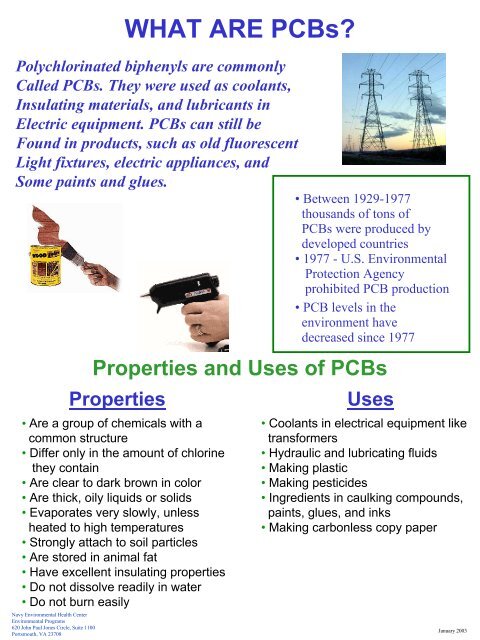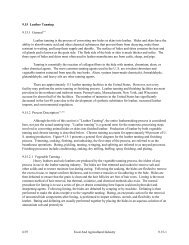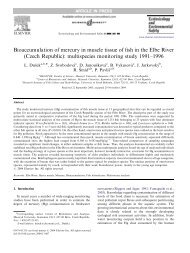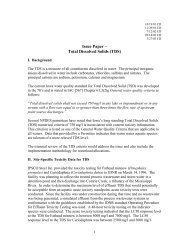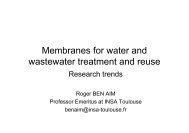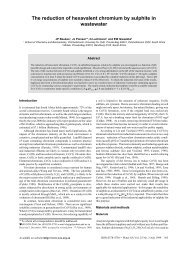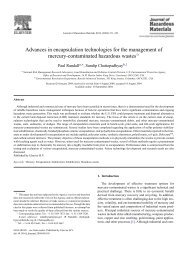WHAT ARE PCBs?
WHAT ARE PCBs?
WHAT ARE PCBs?
- No tags were found...
You also want an ePaper? Increase the reach of your titles
YUMPU automatically turns print PDFs into web optimized ePapers that Google loves.
<strong>WHAT</strong> <strong>ARE</strong> <strong>PCBs</strong>?Polychlorinated biphenyls are commonlyCalled <strong>PCBs</strong>. They were used as coolants,Insulating materials, and lubricants inElectric equipment. <strong>PCBs</strong> can still beFound in products, such as old fluorescentLight fixtures, electric appliances, andSome paints and glues.Properties and Uses of <strong>PCBs</strong>Properties• Are a group of chemicals with acommon structure• Differ only in the amount of chlorinethey contain• Are clear to dark brown in color• Are thick, oily liquids or solids• Evaporates very slowly, unlessheated to high temperatures• Strongly attach to soil particles• Are stored in animal fat• Have excellent insulating properties• Do not dissolve readily in water• Do not burn easilyNavy Environmental Health CenterEnvironmental Programs620 John Paul Jones Circle, Suite 1100Portsmouth, VA 23708• Between 1929-1977thousands of tons of<strong>PCBs</strong> were produced bydeveloped countries• 1977 - U.S. EnvironmentalProtection Agencyprohibited PCB production• PCB levels in theenvironment havedecreased since 1977Uses• Coolants in electrical equipment liketransformers• Hydraulic and lubricating fluids• Making plastic• Making pesticides• Ingredients in caulking compounds,paints, glues, and inks• Making carbonless copy paperJanuary 2003
EXPOSED POPULATIONSCERTAINWORKERS CANCOME INTOCONTACT WITH<strong>PCBs</strong> DURINGREPAIR OFEQUIPMENT,ACCIDENTS ORSPILLS.<strong>PCBs</strong> stay in theenvironment fora long time andconcentrate upin the food chain.Possible Job Related ContactsElectric cable repairElectroplatingEmergency ResponseFirefightingHazardous waste hauling/siteoperatingHeat exchanging equipment repairMetal finishingPaving and roofingPipefitting/plumbingTimber product manufacturingTransformer/capacitor repairWaste oil processingPossible Non-Job Related Contacts• Contact with waste oils that have been illegally dumped on the roadside• Breathing smoke and soot from transformer or capacitor fires• Eating fish and shellfish that contains <strong>PCBs</strong>Special Populations at RiskNavy Environmental Health CenterEnvironmental Programs620 John Paul Jones Circle, Suite 1100Portsmouth, VA 23708• Fetuses (babies before birth) and nursing infants whosemothers are exposed• People with liver disorders• People who use certain medications that may harm the liverJanuary 2003
EFFECTS OF <strong>PCBs</strong><strong>PCBs</strong> in the Body• Absorbed <strong>PCBs</strong> are slowly removed by natural body processes.• Until removed, <strong>PCBs</strong> are stored in fat.• Slow removal by the body causes <strong>PCBs</strong> to accumulate in someanimals.• Some animals are much more affected by <strong>PCBs</strong> than others.Effects onLaboratoryAnimals• Decreased birthweight whenexposed at high doses.• Tumors occur in some exposedanimals.• EPA considers <strong>PCBs</strong> to beprobable human carcinogens(cancer-causing substances).Known Human Effects• The only proven effect in humans ischloracne, a skin condition similar to acne.• Chloracne is resistant to treatment.• Chloracne will go away after exposure isstopped.Navy Environmental Health CenterEnvironmental Programs620 John Paul Jones Circle, Suite 1100Portsmouth, VA 23708January 2003


